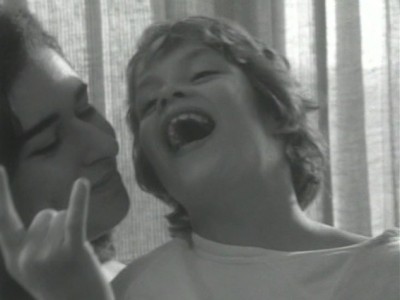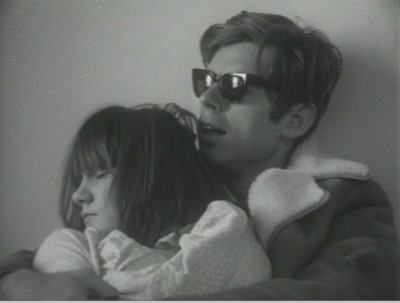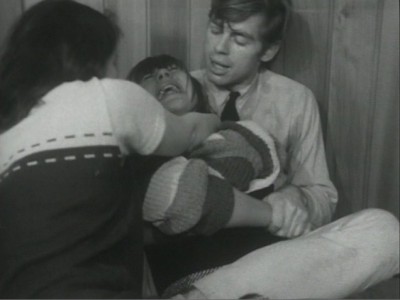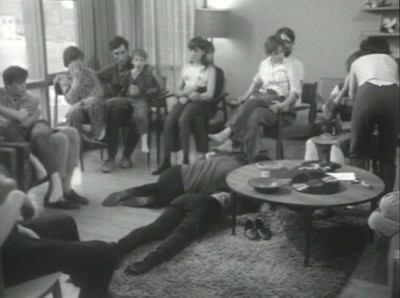| Reviews & Columns |
|
Reviews DVD TV on DVD Blu-ray 4K UHD International DVDs In Theaters Reviews by Studio Video Games Features Collector Series DVDs Easter Egg Database Interviews DVD Talk Radio Feature Articles Columns Anime Talk DVD Savant Horror DVDs The M.O.D. Squad Art House HD Talk Silent DVD
|
DVD Talk Forum |
|
|
| Resources |
|
DVD Price Search Customer Service #'s RCE Info Links |
|
Columns
|
|
|
Warrendale
While Titicut Follies was shot and edited as an exposé outing the deplorable conditions mentally-ill men were being subjected to under the care of the State of Massachusetts, Warrendale doesn't betray how the filmmaker feels about the treatment the emotionally-disturbed children under the care of a Canadian group home are receiving. Thus, where Wiseman invites the viewer to share his outrage, King's opinion remains inscrutable.
There's an intimacy between King and his documentary participants that's distinct as well. To achieve it, he spent four weeks in the group home with the children and therapists alone and without a camera. When the children and therapists were thoroughly comfortable with his presence, he brought cameraman William Brayen and sound man Russel Heise in as well for another two weeks before shooting the first foot of film.


The Warrendale facility is home to twelve emotionally disturbed boys and girls who appear to be between the ages of 10 and 17. The children are cared for by a staff of eight on site, as well as additional therapists and teachers at an adjacent school, but King primarily focuses on two counselors, Terry and Walter, and three children, teens Irene and Carol, and pre-adolescent Tony.
The counselors at Warrendale practice a therapeutic technique referred to in the film as "holding" whereby a child acting out in a way that might lead to harm to himself or those around him is physically restrained by one or more counselors until the rage has subsided. The restraint is not intended as physical punishment, and in fact, the counselors are trained in applying the technique to avoid physically harming the child. The therapeutic intent behind the practice is to cathartically release the child's rage, break down psychological defenses, and promote the child's attachment to the caregiver.
The first time holding therapy is documented in Warrendale is incredibly unsettling, and it never gets any easier to see. Each time a child is restrained is as gut wrenching as the last. That's not meant to be a judgment call about the appropriateness of the technique, only an observation about the impact of watching it.


It's worth repeating that the power of this film partly derives from the fact that it isn't propaganda for or against this therapeutic technique. King dispassionately documents, and leaves it to the viewer to decide what to make of it. This isn't to say that King invites dispassionate detachment on the part of the viewer, far from it. I think King expects to provoke a strong reaction in the viewer, but he leaves it to each viewer to decide the nature of that reaction.
Warrendale was commissioned by the Canadian Broadcast Corporation as a television documentary, but the CBC found King's film too shocking for television. Instead, Warrendale was shown on the festival circuit where it was named the best documentary of the year by the National Society of Film Critics and the British Film Critics Society, and shared with Michelangelo Antonioni's Blow-up, the International Federation of Film Critics Prize at the 1967 Cannes Festival.
The DVD
Warrendale is offered on DVD-R in an alpha case with good laser-print artwork, directly from Allan King Films for $30, plus shipping.
Video:
The back and white image looks very good considering that the source material is 40-year-old 16mm film shot using natural light. There are some scratches and dirt on the original negative that are carried forward on the DVD, but the DVD authoring is itself well done without ghosting, combing or other distortions common in analog to digital transfers of this kind.
Audio:
The original mono audio is directed to the left and right front speakers. The original audio recordings for Warrendale were less than perfect. Dialogue is frequently indistinct either because the speaker is far from the mic, or because of background noise, or, as in the case of Tony, because the speaker simply mumbles. Regardless of the reason, the result is that some of the dialogue is simply unintelligible.
Unfortunately, there are also no subtitles offered on this release, though this lack of subtitles may be because not even Allan King or sound man Russel Heise can make out much of what's being said.
Extras:
The only extra on this release is a trailer for other Allan King films.
Final Thoughts:
There are countless films that are so wonderfully engaging that they seem to end nearly as soon as they've begun and the viewer is left wondering where the time went. Warrendale is not one of those films. If you watch Warrendale you'll be aware of every one of those one-hundred minutes. This film is no less demanding of attention than the children it documents. Before you watch this one, go to the bathroom, turn off your phone, put away your laptop, hide the remote, and vow to stick with it through to the end without physically walking away, or mentally shutting off - the reward is worth it. This is a film that will stick with you long after the memories of all those summer blockbusters have faded.
Taking my cue from Allan King, I won't say how I ultimately came out feeling about the ethics of holding as a therapeutic technique, but I will admit that Warrendale left me with the urge to look into the literature that's been written about holding over the past forty years. Though I'd recommend seeing this documentary before diving into the literature, when you're ready to do so search for "attachment therapy."
Very highly recommended.
|
| Popular Reviews |
| Sponsored Links |
|
|
| Sponsored Links |
|
|
| Release List | Reviews | Shop | Newsletter | Forum | DVD Giveaways | Blu-Ray | Advertise |
|
Copyright 2024 DVDTalk.com All Rights Reserved. Legal Info, Privacy Policy, Terms of Use,
Manage Preferences,
Your Privacy Choices | |||||||













